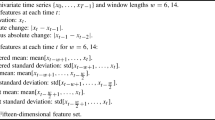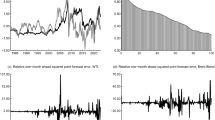Abstract
In the last twenty years, following the introduction of the ARCH and GARCH models, there has been wide-ranging research that extends the models to capture various nuances of financial data. One key area of research generalizes the models to capture the asymmetry related to the so called leverage effect. Although many different asymmetric GARCH type models have been developed, it still remains a challenge to capture the local nature of the leverage effect along with the corresponding interplay between the sign and magnitude of returns. In this paper we propose a new data-dependent approach to modeling financial time series volatility. This method allows self-detection of the presence of leverage effect. The proposed model also automatically adjusts the time-dependent random coefficients in an efficient manner. The examples show the flexibility and general superiority of the proposed model compared to some of the well-known asymmetric GARCH models.
Similar content being viewed by others
References
Aydemir, A., Gallmeyer, M. and Hollifield, B. 2006 Financial leverage does not cause leverage effect.
Baillie, R., Bollerslev, T. and Mikkelsen, H. (1996). Fractionally Integrated Generalized Autoregressive Conditional Heteroskedasticity. Journal of Econometrics 74, 3–30.
Black, F. (1976) Studies of Stock Price Volatility Changes. In Meetings of the Business and Economic Statistics Section, ASA. American Statistical Association. pp. 177– 181.
Bollerslev, T. (1986). Generalized autoregressive conditional heteroskedasticity. Journal of Econometrics 31, 307–327.
Bouchaud, J-P., Matacz, A. and Potters, M. (2001). Leverage effect in financial market: the retarded volatility model. Physical Review Letters 87, 22, 228701.
Bougerol, P. and Picard, N. (1992). Stationarity of garch processes and of some nonnegative time series. Journal of Econometrics 52, 115–127.
Breen, W., Glosten, L. and Jagannathan, R. (1989). Economic Significance of Predictable Variations in Stock Index Returns. Journal of Finance 44, 1177– 1189.
Brockwell, P. and Davis, R. (1987). Time Series: Theory and Methods, 2nd edn. Springer, New York.
Campbell, J. (1987). Stock Returns and the Term Structure. Journal of Financial Economics 18, 373–399.
Campbell, J. and Hentschel, L. (1992). No news is good news: An asymmetric model of changing volatility in stock returns. Journal of Financial Economics 31, 3, 281– 318.
Caporin, M. and Mcaleer, M. (2006). Dynamic Assymetric garch. Journal of Financial Econometrics 4, 385–412.
Chan, K., Karolyi, G. and Stulz, R. (1992). Global financial markets and the risk premium on U.S. equity. Journal of Financial Economics 32, 137–167.
Cleveland, W. (1979). Robust locally weighted regression and smoothing scatterplots. Journal of the American Statistical Association 74, 829–836.
Di, J. and Gangopadhyay, A. (2011). On the efficiency of a semi-parametric GARCH model. The Econometrics Journal 14, 257–277.
Engle, R. (1982). Autoregressive conditional heteroskedasticity with estimates of the variance of united kindom inflation. Econometrica 50, 987–1007.
Engle, R. and Bollerslev, T. (1986). Modeling the persistence of conditional variances. Econometric Reviews 5, 1–50.
Fama, E. and Schwert, W. (1977). Asset returns and inflation. Journal of Financial Economics 5, 115–146.
Foster, D. and Nelson, D. (1996). Continuous record asymptotics for rolling sample variance estimators. Econometrica 64, 1, 139–74.
French, K., Schwert, W. and Stambaugh, R. (1987). Expected stock returns and volatility. Journal of Financial Economics 19, 3–29.
Glosten, R., Jagannathan, R., and Runkle, E. (1993). On the relation between the expected value and the volatility of the nominal excess return on stocks. Journal of Finance 48, 5, 1779–1801.
Harvey, C. 1991 The Specification of Conditional Expectations. Unpublished Manuscript, Duke University.
Harvey, C. and Siddique, A. (1999). Autoregressive conditional skewness. Journal of Financial and Quantitative Analysis 34, 465–487.
Hentschel, L. (1995). All in the family nesting symmetric and asymmetric garch models. Journal of Financial Economics 39, 1, 71–104.
Higgins, M. and Bera, A. (1992). A class of nonlinear arch models. International Economic Review 33, 1, 137–58.
Hsu, D., Miller, R. and Wichern, D. (1974). On the stable paretian behavior of stock-market prices. Journal of American Statistical Association 69, 108–113.
Hyndman, R. (1994) Time series data library. http://www-personal.buseco.monash.edu.au/hyndman/TSDL/, http://robjhyndman.com/TSDL/.
León, A., Rubio, G. and Serna, G. (2004) Autoregressive Conditional Volatility, Skewness and Kurtosis. IVIE working paper.
Merton, R. (1980). On estimating the expected return on the market: An exploratory investigation. Journal of Financial Economics 8, 323–361.
Nelson, D. (1990). Stationarity and persistence in the garch(1,1) model. Econometric Theory 6, 3, 318–334.
Nelson, D. (1991). Conditional heteroskedasticity in asset returns: A new approach. Econometrica 59, 347–370.
Officer, R. (1973). The variability of the market factor of the new york stock exchange. Journal of Business 46, 3, 434–453.
Zakoïan, J-M. (1994). Threshold heteroskedastic models. Journal of Economic Dynamics and Control 18, 5, 931–955.
Author information
Authors and Affiliations
Corresponding author
Rights and permissions
About this article
Cite this article
Di, J., Gangopadhyay, A. A Data-Dependent Approach to Modeling Volatility in Financial Time Series. Sankhya B 77, 1–26 (2015). https://doi.org/10.1007/s13571-014-0094-7
Received:
Revised:
Published:
Issue Date:
DOI: https://doi.org/10.1007/s13571-014-0094-7
Keywords and phrases
- Asymmetric GARCH
- random models
- time-varying asymmetry
- dynamic volatility
- local cross-correlation
- self-adjusting




